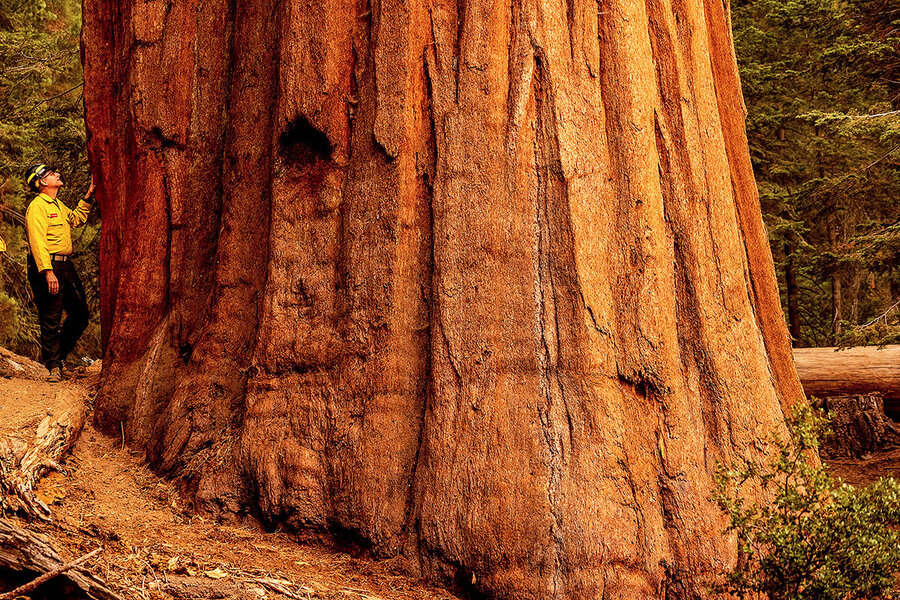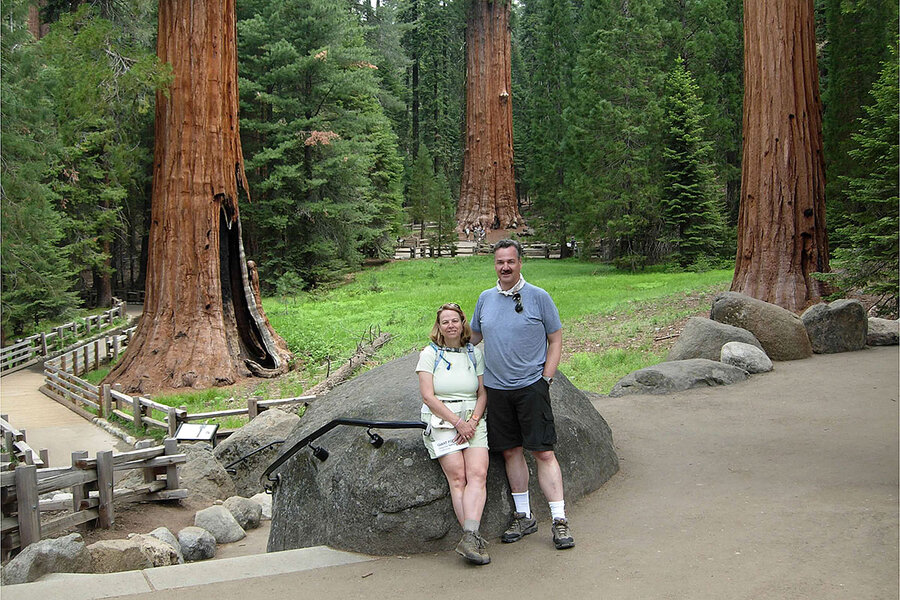The battle to save Earth’s largest tree from California’s wildfires
Loading...
| PASADENA, CALIF.
Like so many others, I was concerned when I learned that the KNP Complex fire in California’s Sierra Nevada was dangerously close to the Giant Forest in Sequoia National Park. That’s where the famous – and ginormous – General Sherman tree has stood for thousands of years.
Then I began learning about what all the firefighters are doing to save the sequoias, and my initial “Oh no!” turned into an “Oh my!” Crews have raked the forest floor, burned duff from around the base of individual trees, and wrapped the General Sherman and other named trees in foil reaching 10 to 15 feet high. It’s the same material that firefighters carry to protect themselves in case of a burn-over.
Why We Wrote This
Firefighters fought tirelessly over recent days to save one of California’s sequoia groves, and its famous General Sherman tree. Efforts to preserve these trees underscore their magnificence – and a resilience that’s challenged by changing climate conditions.
Sequoias are used to fire, said Jon Wallace, the fire’s operation section chief, at a briefing Friday evening. But “we’re taking extra steps to really try to protect those trees,” he added. That’s especially true of the General Sherman. At 275 feet high and more than 36 feet in diameter at the base, it’s the largest tree by volume on the planet.
“We’ll save the Sherman before anything else,” fire information officer Mark Garrett says. For now, it seems, they have.
My heart skipped a beat when I read last week that the KNP Complex fire in California’s Sierra Nevada was within a mile of the Giant Forest in Sequoia National Park; just a mile from the park’s main attraction: ginormous, ancient sequoias that include the biggest tree on Earth – the General Sherman.
Oh no! Like millions of people from around the world, I have enjoyed this spectacular park. Not as heavily visited as its majestic, granite cousin Yosemite to the north, Sequoia is all about the trees: craning your neck to see blue sky past evergreens as tall as skyscrapers, walking paths among old-growth behemoths that go back to biblical times, spreading your arms across a tree trunk that’s impossible to hug for its tremendous girth.
But I should have known that firefighters would do everything they could to save this world-renowned forest of nearly 2,000 giant sequoias – trees found only in California. This fire has been designated one of the highest priority fires in the United States. To prepare the Giant Forest, crews have raked the forest floor, burned debris from around the base of individual trees, and wrapped the General Sherman and other named trees in foil reaching 10 to 15 feet high. It’s the same material that firefighters carry to protect themselves in case of a burn-over.
Why We Wrote This
Firefighters fought tirelessly over recent days to save one of California’s sequoia groves, and its famous General Sherman tree. Efforts to preserve these trees underscore their magnificence – and a resilience that’s challenged by changing climate conditions.
Roads and parking lots provide firefighters access to lay their hoses and run sprinklers pretty much nonstop around the structures in the Giant Forest, and around key lodging and visitor areas elsewhere in the park.
Sequoias are used to fire, said Jon Wallace, the fire’s operation section chief, at a community briefing in the nearby community of Three Rivers Friday evening. But at this level of dryness, “we’re taking extra steps to really try to protect those trees.”
These giants have seen hundreds of fires over their lifetimes of 2,000 to 3,000 years. Thick bark protects them from flames, and the heat from fires forces cones to release their seeds. Branches starting 100 feet up protect the trees’ crowns from flames on the ground. Unusually, the park has a long history of low-intensity prescribed burns dating back to the late 1960s. Over the weekend, the KNP Complex fire had reached the western edge of the Giant Forest, but as Mr. Wallace noted, because of the park’s “impressive” practice of prescribed burns, “there’s not a lot to burn” in the area, and flames have dropped down to 2 to 3 feet.
As of Monday morning, fire had touched only a few sequoias in that western edge – the Four Guardsman – but no giants have been damaged or killed, according to Mark Garrett, a spokesman for the KNP Complex fire. Firefighters have been able to “corral” the low-intensity fire in that area, he said.
Sparked by lightning on Sept. 9, the KNP Complex fire is still 0% contained under red-flag conditions, consuming at least 23,700 acres so far, much of it in unreachable, rugged terrain. But in the much-visited Giant Forest, which sits on a kind of plateau with walking trails, protection efforts are going “really, really well,” said Mr. Wallace at a briefing Sunday morning.
Things did not go well with the Castle fire last year that killed 10% to 14% of the world’s large sequoia population in California’s Sierra Nevada – about 7,500 to 10,600 trees, according to the National Park Service. A history of fire suppression combined with hotter droughts driven by climate change are causing higher flames and hotter fires, say park officials. So far this year, wildfires have burned more than 2 million acres in California, closing Lassen Volcanic National Park in the northern part of the state, Sequoia, and much of neighboring Kings Canyon National Park.
“Yes, fires are beneficial in many cases, but I think what we’re seeing now is a severity and intensity, and too many of them, and that is not really good for the ecology of many of these parks,” says Ana Beatriz Cholo, a spokeswoman for the National Park Service.
Ms. Cholo was recently at Lassen, which is still closed due to the Dixie fire, California’s second-largest fire in history, burning nearly a million acres. Firefighters have been able to save a number of structures and “special spots” for visitors, she says.
And so it is with the General Sherman tree – 275 feet high and more than 36 feet in diameter at the base. That makes it the largest tree by volume on the planet. “We’ll save the Sherman before anything else,” says Mr. Garrett. The General Sherman so far hasn’t even seen fire, he says, because it’s on the northern side of the Giant Forest, and is buffered by a parking lot, a road, and the prescribed burning.
In a few months, even intensely burned areas in the park will see “green stuff sprouting all over,” including ferns, grasses, and shrubs, says Mr. Garrett. Up in the Giant Forest, there will potentially be seedlings, helped by minerals and more sunlight. “Once the fire moves through there, we can see a healthier forest.”
This caused my “Oh no!” to turn into “Oh my!” – at the wonder of the tremendous effort to protect this grove for future visitors, and at these towering sentinels of the forest themselves. It looks like the resilience of these sequoias, aided by people working to save them, will preserve these magnificent trees for future generations of awe-inspired visitors.










